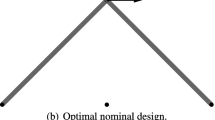Abstract
A computational method is presented for finding a sequence of optimum designs of a discrete system which exhibits limit point behaviour. Optimality conditions are derived in terms of the theory of imperfection sensitivity coefficients for the limit point load factor. Only those designs of the structures which exhibit limit point behaviour are considered as feasible designs, and the design change is conceived as generating a kind of imperfection. The efficiency of the proposed algorithm will be appreciated particularly for large structures, because incremental nonlinear analysis to find the limit point load factor needs to be carried out only once for the structure of trivial initial optimum design. The sequence of optimum designs is described by piecewise Taylor series expansions with respect to the specified limit point load factor. It is shown in the examples that the proposed method is efficient and of good accuracy for a large space truss.
Similar content being viewed by others
References
Hearn, A.C. 1987:Reduce user's manual, version 3.3. The Rand Corporation: Santa Monica
Kamat, M.P.; Khot, N.S.; Venkayya, V.B. 1984: Optimization of shallow trusses against limit point instability.AIAA J. 22, 403–408
Kamat, M.P.; Ruangsilasingha, P. 1985: Optimization of space trusses against instability using design sensitivity derivatives.Engng. Opt. 8, 177–188
Khot, N.S. 1983: Nonlinear analysis of optimized structure with constraints on system stability.AIAA J. 21, 1181–1186
Khot, N.S.; Kamat, M.P. 1985: Minimum weight design of truss structures with geometric nonlinear behavior.AIAA J. 23, 139–144
Khot, N.S.; Venkayya, V.B.; Berke, L. 1976: Optimum structural design with stability constraints.Int. J. Numer. Meth. Engng. 10, 1097–1114
Levy, R.; Perng, H. 1988: Optimization for nonlinear stability.Comput. & Struct. 30, 529–535
Lin, C.C.; Liu, I.W. 1989: Optimal design based on optimality criterion for frame structures including buckling constraints.Comput. & Struct. 31, 535–544
Nakamura, Tsuneyoshi; Ohsaki, M. 1988: Sequential optimal truss generator for frequency ranges.Comp. Meth. Appl. Mech. Engng. 67, 189–209
Nakamura, Tsuneyoshi; Ohsaki, M. 1989: Sequential generator of earthquake-response constrained trusses for design strain ranges.Comput. & Struct. 33, 1403–1416
Nakamura, Tsuneyoshi; Ohsaki, M. 1992: A natural generator of optimum topology of plane trusses for specified fundamental frequency.Comp. Meth. Appl. Mech. Engng. 94, 113–129
Nakamura, Tsuneyoshi; Ohsaki, M.; Masui, T. 1992: Inverse generation of earthquake-strain constrained designs of a distributed parameter structure for a sequence of design strain functions.Comp. Meth. Appl. Mech. Engng. 98, 1–21
Park, J.S.; Choi, K.K. 1990: Design sensitivity analysis of critical load factor for nonlinear structural systems.Comp. & Struct. 36, 823–838
Plaut, R.H.; Ruangsilasingha, P.; Kamat, M.P. 1984: Optimization of an asymmetric two-bar truss against instability.J. Struct. Mech. 12, 465–470
Prager, W.; Taylor, J.E. 1968: Problem of optimal structural design.J. Appl. Mech. 35, 102–106
Pyrz, M. 1990a: Discrete optimization of geometrically nonlinear truss structures under stability constraints.Struct. Optim. 2, 125–131
Pyrz, M. 1990b: Discrete optimization of trusses with stability constraints.Engng. Optimiz. 16, 79–89
Saka, M.P. 1988: Optimum design of nonlinear space trusses.Comput. & Struct. 30, 545–551
Santos, J.L.T.; Choi, K.K. 1988: Sizing design sensitivity analysis of non-linear structural systems. Part II: numerical method.Int. J. Numer. Meth. Engng. 26, 2097–2114
Thompson, J.M.T. 1969: A general theory for the equilibrium and stability of discrete conservative systems.ZAMP 20, 797–846
Thompson, J.M.T.; Hunt, G.W. 1973:A general theory of elastic stability. New York: John Wiley & Sons
Wu, C.C.; Arora, J.S. 1987: Design sensitivity analysis and optimization of nonlinear structural response using incremental procedure.AIAA J. 25, 1118–1125
Wu, C.C.; Arora, J.S. 1988: Design sensitivity analysis of nonlinear buckling load.Comp. Mech. 3, 129–140
Author information
Authors and Affiliations
Rights and permissions
About this article
Cite this article
Ohsaki, M., Nakamura, T. Optimum design with imperfection sensitivity coefficients for limit point loads. Structural Optimization 8, 131–137 (1994). https://doi.org/10.1007/BF01743310
Received:
Revised:
Issue Date:
DOI: https://doi.org/10.1007/BF01743310




